Application of the Transtheoretical Model of Change in Health Care
VerifiedAdded on 2022/12/23
|9
|2646
|1
Report
AI Summary
This report delves into the Transtheoretical Model of Change (TTM) and its application within healthcare contexts. The assignment aims to elucidate the TTM's core principles, emphasizing its role in facilitating behavioral changes, particularly within health interventions. The report presents a comprehensive overview of the TTM, outlining its distinct stages—precontemplation, contemplation, preparation, action, maintenance, and termination—and the processes involved in each. A case study involving an individual seeking to manage weight is analyzed to illustrate the practical implementation of the TTM, including the use of motivational interviewing techniques. Furthermore, the report examines the existing literature, providing evidence and insights from various studies to support the effectiveness of the model. The report concludes by summarizing the TTM's significance in healthcare and its potential for guiding individuals toward adopting and maintaining healthier behaviors. The report uses evidence from various health organizations and programs to support the model's effectiveness.
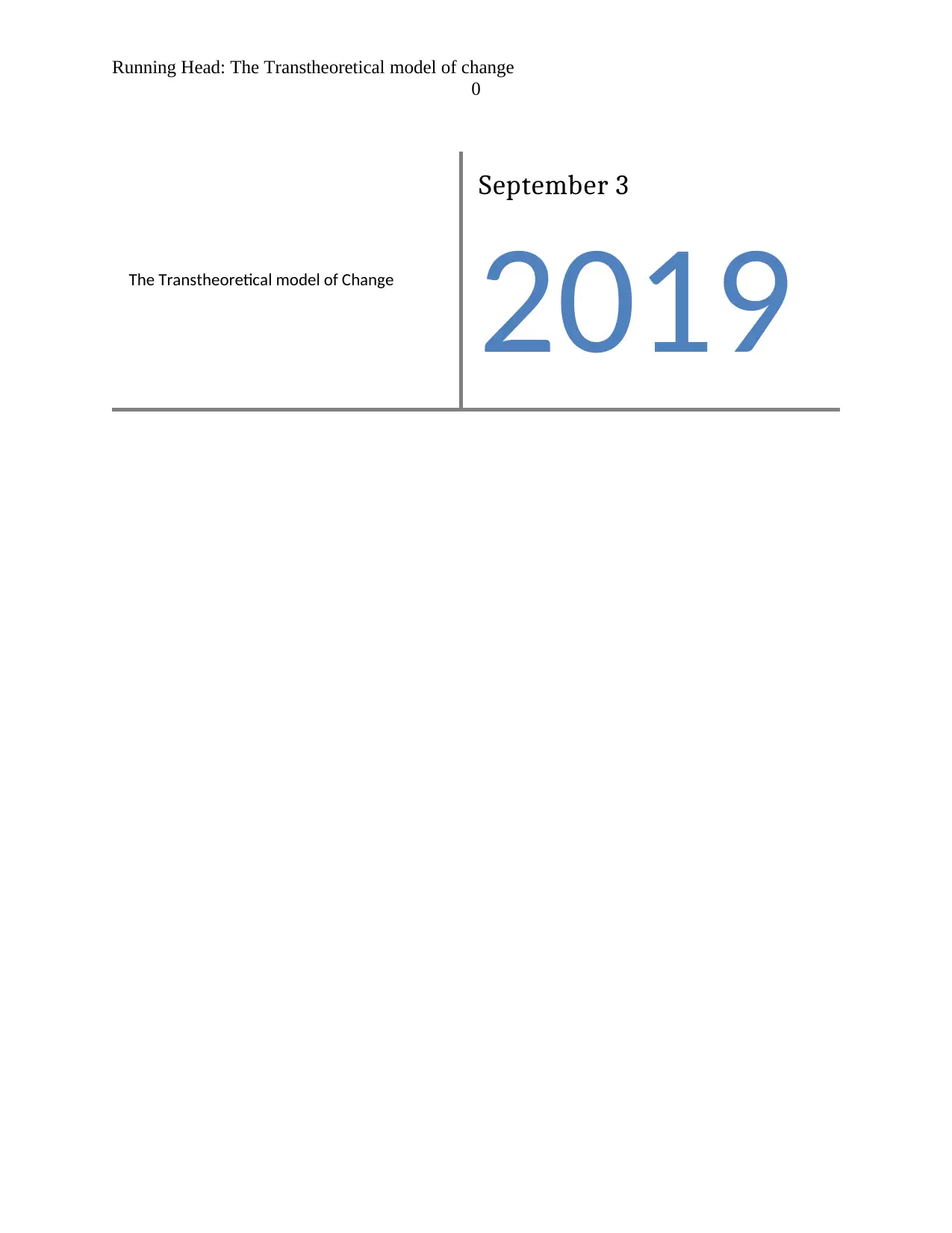
Running Head: The Transtheoretical model of change
0
The Transtheoretical model of Change
September 3
2019
0
The Transtheoretical model of Change
September 3
2019
Paraphrase This Document
Need a fresh take? Get an instant paraphrase of this document with our AI Paraphraser
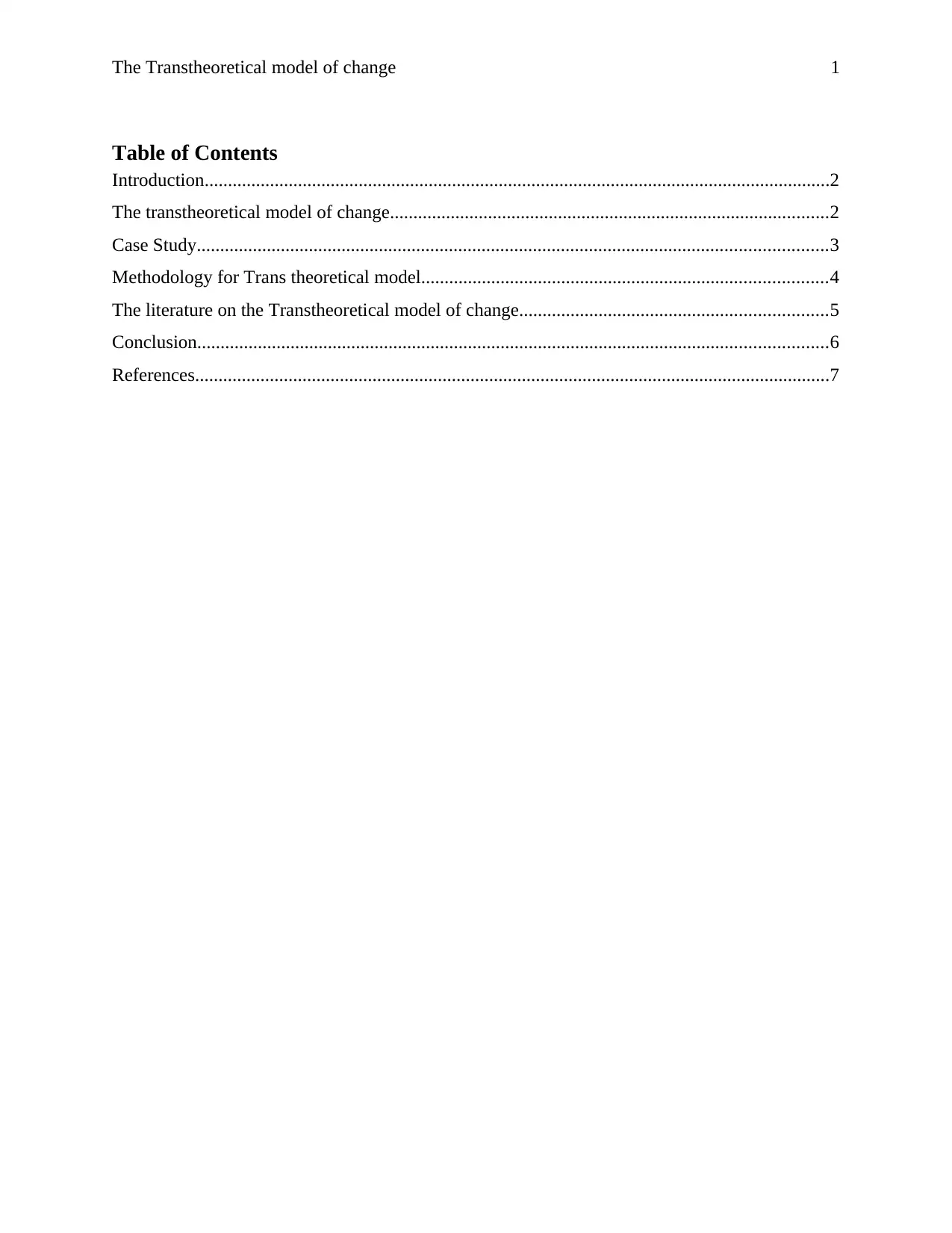
The Transtheoretical model of change 1
Table of Contents
Introduction......................................................................................................................................2
The transtheoretical model of change..............................................................................................2
Case Study.......................................................................................................................................3
Methodology for Trans theoretical model.......................................................................................4
The literature on the Transtheoretical model of change..................................................................5
Conclusion.......................................................................................................................................6
References........................................................................................................................................7
Table of Contents
Introduction......................................................................................................................................2
The transtheoretical model of change..............................................................................................2
Case Study.......................................................................................................................................3
Methodology for Trans theoretical model.......................................................................................4
The literature on the Transtheoretical model of change..................................................................5
Conclusion.......................................................................................................................................6
References........................................................................................................................................7
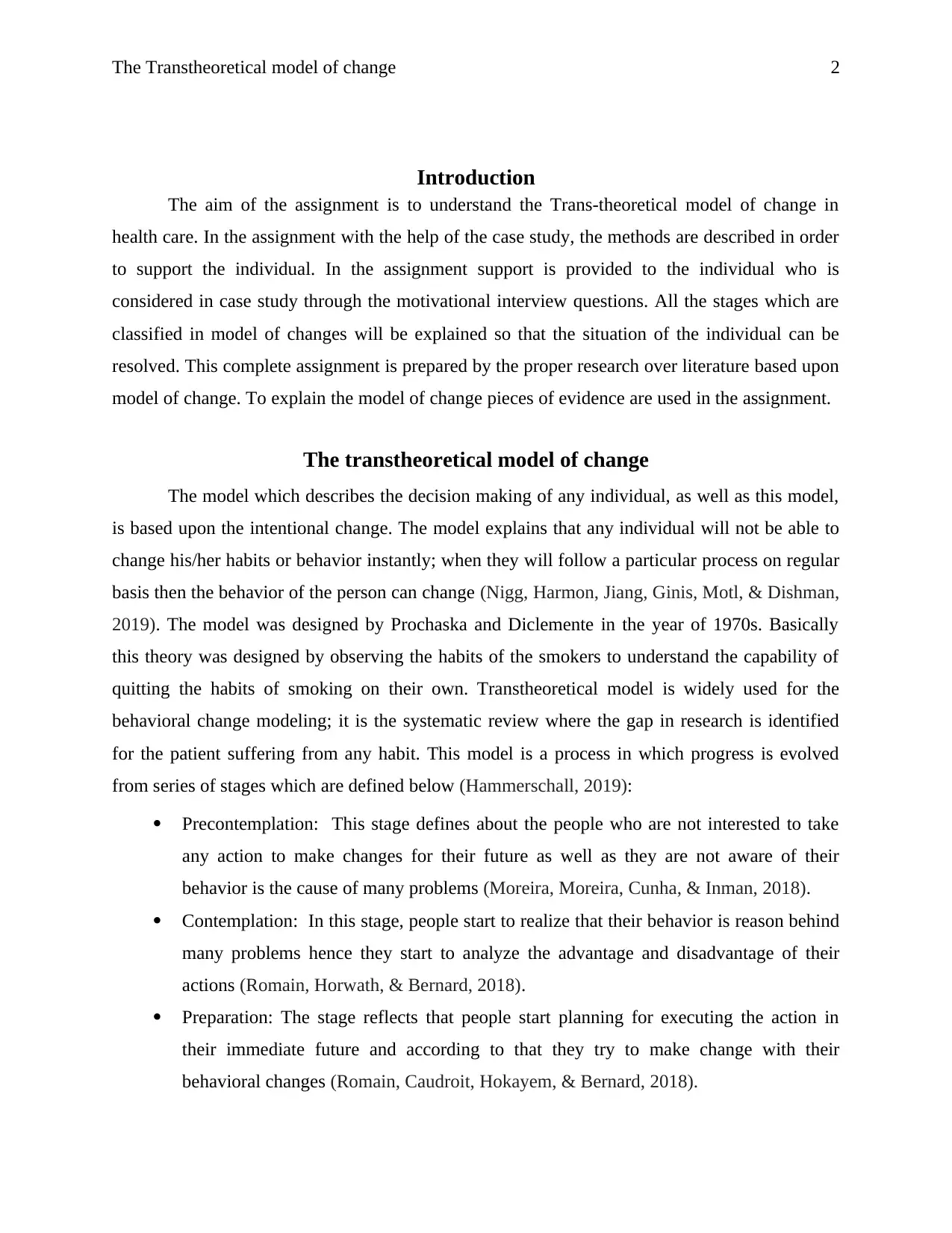
The Transtheoretical model of change 2
Introduction
The aim of the assignment is to understand the Trans-theoretical model of change in
health care. In the assignment with the help of the case study, the methods are described in order
to support the individual. In the assignment support is provided to the individual who is
considered in case study through the motivational interview questions. All the stages which are
classified in model of changes will be explained so that the situation of the individual can be
resolved. This complete assignment is prepared by the proper research over literature based upon
model of change. To explain the model of change pieces of evidence are used in the assignment.
The transtheoretical model of change
The model which describes the decision making of any individual, as well as this model,
is based upon the intentional change. The model explains that any individual will not be able to
change his/her habits or behavior instantly; when they will follow a particular process on regular
basis then the behavior of the person can change (Nigg, Harmon, Jiang, Ginis, Motl, & Dishman,
2019). The model was designed by Prochaska and Diclemente in the year of 1970s. Basically
this theory was designed by observing the habits of the smokers to understand the capability of
quitting the habits of smoking on their own. Transtheoretical model is widely used for the
behavioral change modeling; it is the systematic review where the gap in research is identified
for the patient suffering from any habit. This model is a process in which progress is evolved
from series of stages which are defined below (Hammerschall, 2019):
Precontemplation: This stage defines about the people who are not interested to take
any action to make changes for their future as well as they are not aware of their
behavior is the cause of many problems (Moreira, Moreira, Cunha, & Inman, 2018).
Contemplation: In this stage, people start to realize that their behavior is reason behind
many problems hence they start to analyze the advantage and disadvantage of their
actions (Romain, Horwath, & Bernard, 2018).
Preparation: The stage reflects that people start planning for executing the action in
their immediate future and according to that they try to make change with their
behavioral changes (Romain, Caudroit, Hokayem, & Bernard, 2018).
Introduction
The aim of the assignment is to understand the Trans-theoretical model of change in
health care. In the assignment with the help of the case study, the methods are described in order
to support the individual. In the assignment support is provided to the individual who is
considered in case study through the motivational interview questions. All the stages which are
classified in model of changes will be explained so that the situation of the individual can be
resolved. This complete assignment is prepared by the proper research over literature based upon
model of change. To explain the model of change pieces of evidence are used in the assignment.
The transtheoretical model of change
The model which describes the decision making of any individual, as well as this model,
is based upon the intentional change. The model explains that any individual will not be able to
change his/her habits or behavior instantly; when they will follow a particular process on regular
basis then the behavior of the person can change (Nigg, Harmon, Jiang, Ginis, Motl, & Dishman,
2019). The model was designed by Prochaska and Diclemente in the year of 1970s. Basically
this theory was designed by observing the habits of the smokers to understand the capability of
quitting the habits of smoking on their own. Transtheoretical model is widely used for the
behavioral change modeling; it is the systematic review where the gap in research is identified
for the patient suffering from any habit. This model is a process in which progress is evolved
from series of stages which are defined below (Hammerschall, 2019):
Precontemplation: This stage defines about the people who are not interested to take
any action to make changes for their future as well as they are not aware of their
behavior is the cause of many problems (Moreira, Moreira, Cunha, & Inman, 2018).
Contemplation: In this stage, people start to realize that their behavior is reason behind
many problems hence they start to analyze the advantage and disadvantage of their
actions (Romain, Horwath, & Bernard, 2018).
Preparation: The stage reflects that people start planning for executing the action in
their immediate future and according to that they try to make change with their
behavioral changes (Romain, Caudroit, Hokayem, & Bernard, 2018).
You're viewing a preview
Unlock full access by subscribing today!
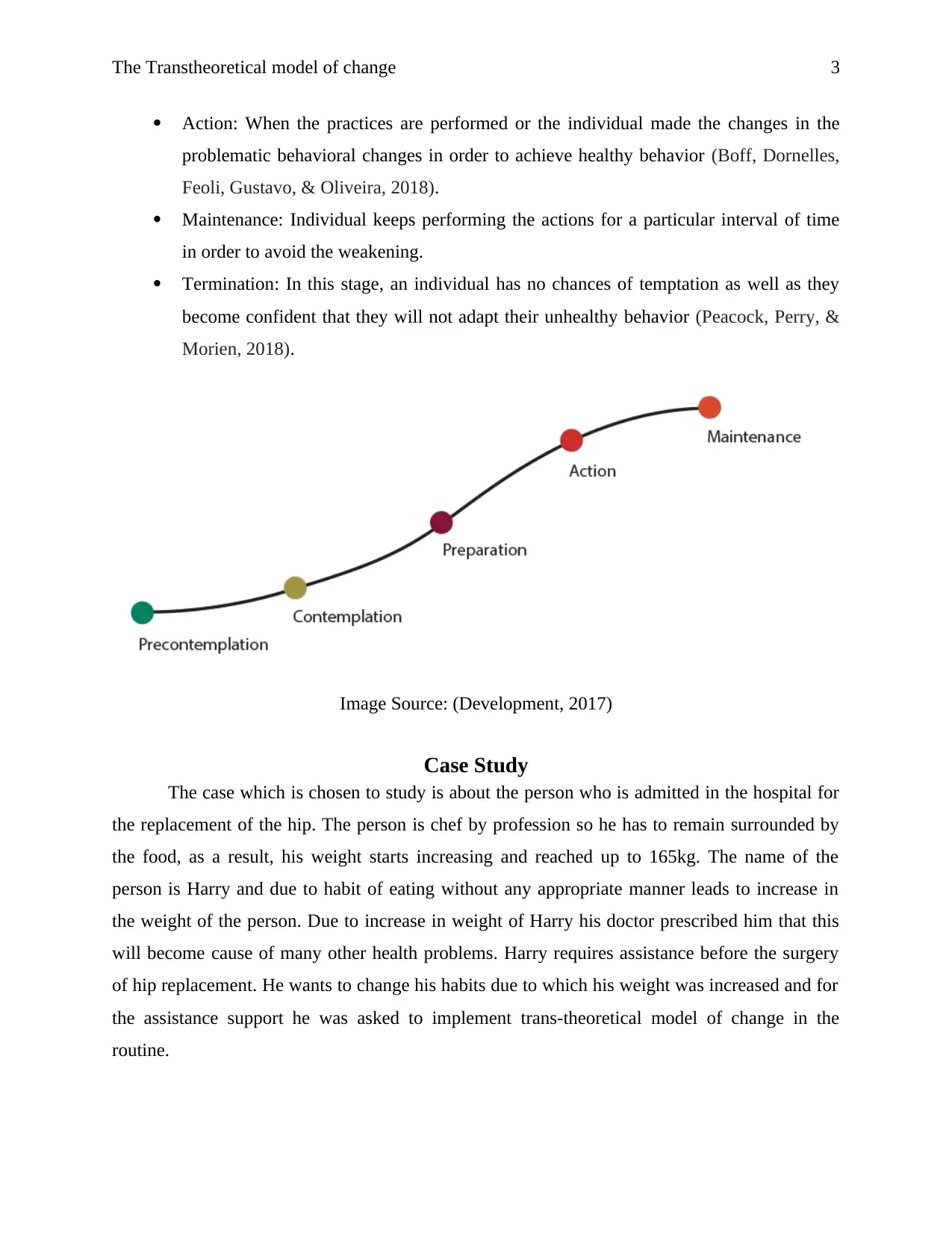
The Transtheoretical model of change 3
Action: When the practices are performed or the individual made the changes in the
problematic behavioral changes in order to achieve healthy behavior (Boff, Dornelles,
Feoli, Gustavo, & Oliveira, 2018).
Maintenance: Individual keeps performing the actions for a particular interval of time
in order to avoid the weakening.
Termination: In this stage, an individual has no chances of temptation as well as they
become confident that they will not adapt their unhealthy behavior (Peacock, Perry, &
Morien, 2018).
Image Source: (Development, 2017)
Case Study
The case which is chosen to study is about the person who is admitted in the hospital for
the replacement of the hip. The person is chef by profession so he has to remain surrounded by
the food, as a result, his weight starts increasing and reached up to 165kg. The name of the
person is Harry and due to habit of eating without any appropriate manner leads to increase in
the weight of the person. Due to increase in weight of Harry his doctor prescribed him that this
will become cause of many other health problems. Harry requires assistance before the surgery
of hip replacement. He wants to change his habits due to which his weight was increased and for
the assistance support he was asked to implement trans-theoretical model of change in the
routine.
Action: When the practices are performed or the individual made the changes in the
problematic behavioral changes in order to achieve healthy behavior (Boff, Dornelles,
Feoli, Gustavo, & Oliveira, 2018).
Maintenance: Individual keeps performing the actions for a particular interval of time
in order to avoid the weakening.
Termination: In this stage, an individual has no chances of temptation as well as they
become confident that they will not adapt their unhealthy behavior (Peacock, Perry, &
Morien, 2018).
Image Source: (Development, 2017)
Case Study
The case which is chosen to study is about the person who is admitted in the hospital for
the replacement of the hip. The person is chef by profession so he has to remain surrounded by
the food, as a result, his weight starts increasing and reached up to 165kg. The name of the
person is Harry and due to habit of eating without any appropriate manner leads to increase in
the weight of the person. Due to increase in weight of Harry his doctor prescribed him that this
will become cause of many other health problems. Harry requires assistance before the surgery
of hip replacement. He wants to change his habits due to which his weight was increased and for
the assistance support he was asked to implement trans-theoretical model of change in the
routine.
Paraphrase This Document
Need a fresh take? Get an instant paraphrase of this document with our AI Paraphraser
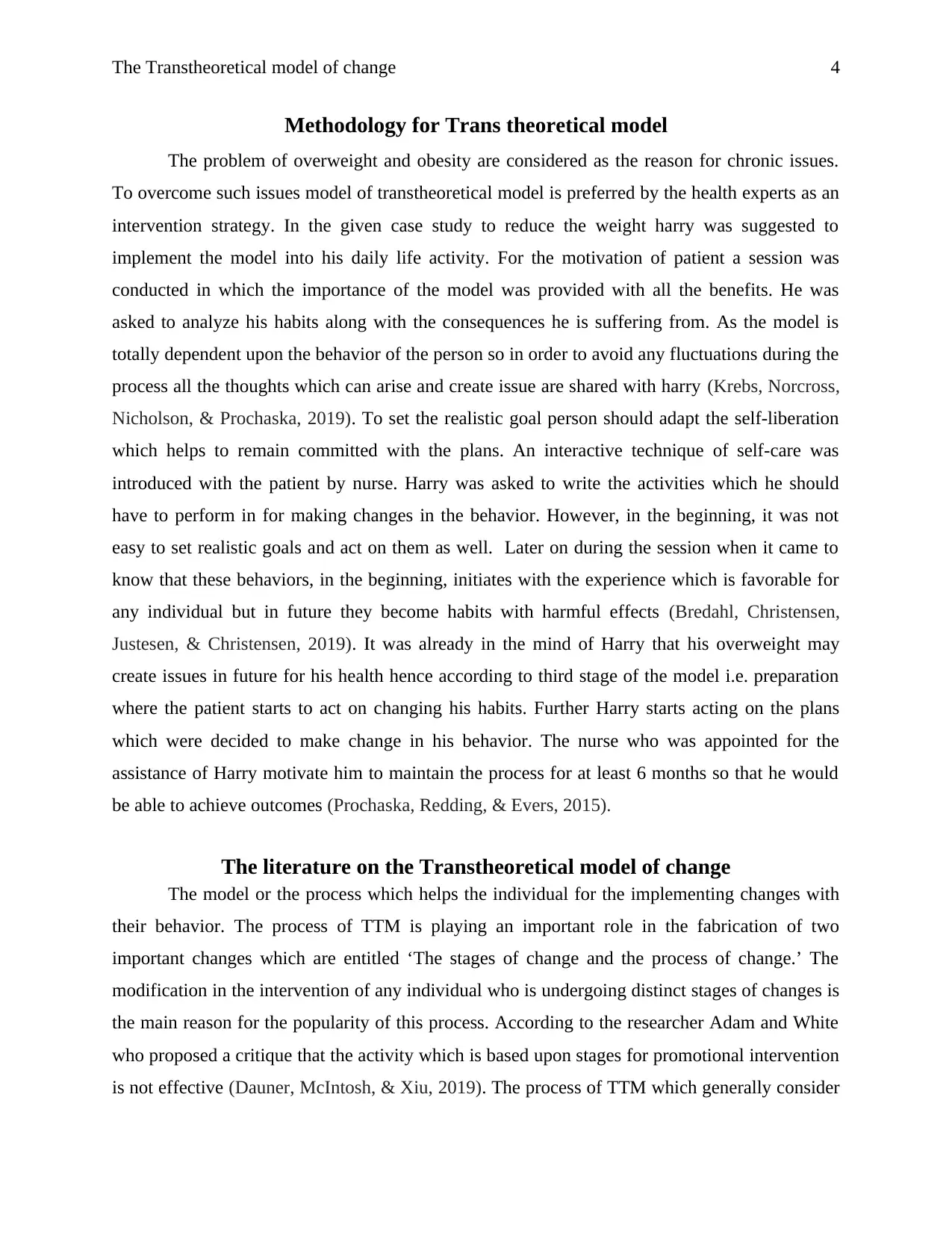
The Transtheoretical model of change 4
Methodology for Trans theoretical model
The problem of overweight and obesity are considered as the reason for chronic issues.
To overcome such issues model of transtheoretical model is preferred by the health experts as an
intervention strategy. In the given case study to reduce the weight harry was suggested to
implement the model into his daily life activity. For the motivation of patient a session was
conducted in which the importance of the model was provided with all the benefits. He was
asked to analyze his habits along with the consequences he is suffering from. As the model is
totally dependent upon the behavior of the person so in order to avoid any fluctuations during the
process all the thoughts which can arise and create issue are shared with harry (Krebs, Norcross,
Nicholson, & Prochaska, 2019). To set the realistic goal person should adapt the self-liberation
which helps to remain committed with the plans. An interactive technique of self-care was
introduced with the patient by nurse. Harry was asked to write the activities which he should
have to perform in for making changes in the behavior. However, in the beginning, it was not
easy to set realistic goals and act on them as well. Later on during the session when it came to
know that these behaviors, in the beginning, initiates with the experience which is favorable for
any individual but in future they become habits with harmful effects (Bredahl, Christensen,
Justesen, & Christensen, 2019). It was already in the mind of Harry that his overweight may
create issues in future for his health hence according to third stage of the model i.e. preparation
where the patient starts to act on changing his habits. Further Harry starts acting on the plans
which were decided to make change in his behavior. The nurse who was appointed for the
assistance of Harry motivate him to maintain the process for at least 6 months so that he would
be able to achieve outcomes (Prochaska, Redding, & Evers, 2015).
The literature on the Transtheoretical model of change
The model or the process which helps the individual for the implementing changes with
their behavior. The process of TTM is playing an important role in the fabrication of two
important changes which are entitled ‘The stages of change and the process of change.’ The
modification in the intervention of any individual who is undergoing distinct stages of changes is
the main reason for the popularity of this process. According to the researcher Adam and White
who proposed a critique that the activity which is based upon stages for promotional intervention
is not effective (Dauner, McIntosh, & Xiu, 2019). The process of TTM which generally consider
Methodology for Trans theoretical model
The problem of overweight and obesity are considered as the reason for chronic issues.
To overcome such issues model of transtheoretical model is preferred by the health experts as an
intervention strategy. In the given case study to reduce the weight harry was suggested to
implement the model into his daily life activity. For the motivation of patient a session was
conducted in which the importance of the model was provided with all the benefits. He was
asked to analyze his habits along with the consequences he is suffering from. As the model is
totally dependent upon the behavior of the person so in order to avoid any fluctuations during the
process all the thoughts which can arise and create issue are shared with harry (Krebs, Norcross,
Nicholson, & Prochaska, 2019). To set the realistic goal person should adapt the self-liberation
which helps to remain committed with the plans. An interactive technique of self-care was
introduced with the patient by nurse. Harry was asked to write the activities which he should
have to perform in for making changes in the behavior. However, in the beginning, it was not
easy to set realistic goals and act on them as well. Later on during the session when it came to
know that these behaviors, in the beginning, initiates with the experience which is favorable for
any individual but in future they become habits with harmful effects (Bredahl, Christensen,
Justesen, & Christensen, 2019). It was already in the mind of Harry that his overweight may
create issues in future for his health hence according to third stage of the model i.e. preparation
where the patient starts to act on changing his habits. Further Harry starts acting on the plans
which were decided to make change in his behavior. The nurse who was appointed for the
assistance of Harry motivate him to maintain the process for at least 6 months so that he would
be able to achieve outcomes (Prochaska, Redding, & Evers, 2015).
The literature on the Transtheoretical model of change
The model or the process which helps the individual for the implementing changes with
their behavior. The process of TTM is playing an important role in the fabrication of two
important changes which are entitled ‘The stages of change and the process of change.’ The
modification in the intervention of any individual who is undergoing distinct stages of changes is
the main reason for the popularity of this process. According to the researcher Adam and White
who proposed a critique that the activity which is based upon stages for promotional intervention
is not effective (Dauner, McIntosh, & Xiu, 2019). The process of TTM which generally consider
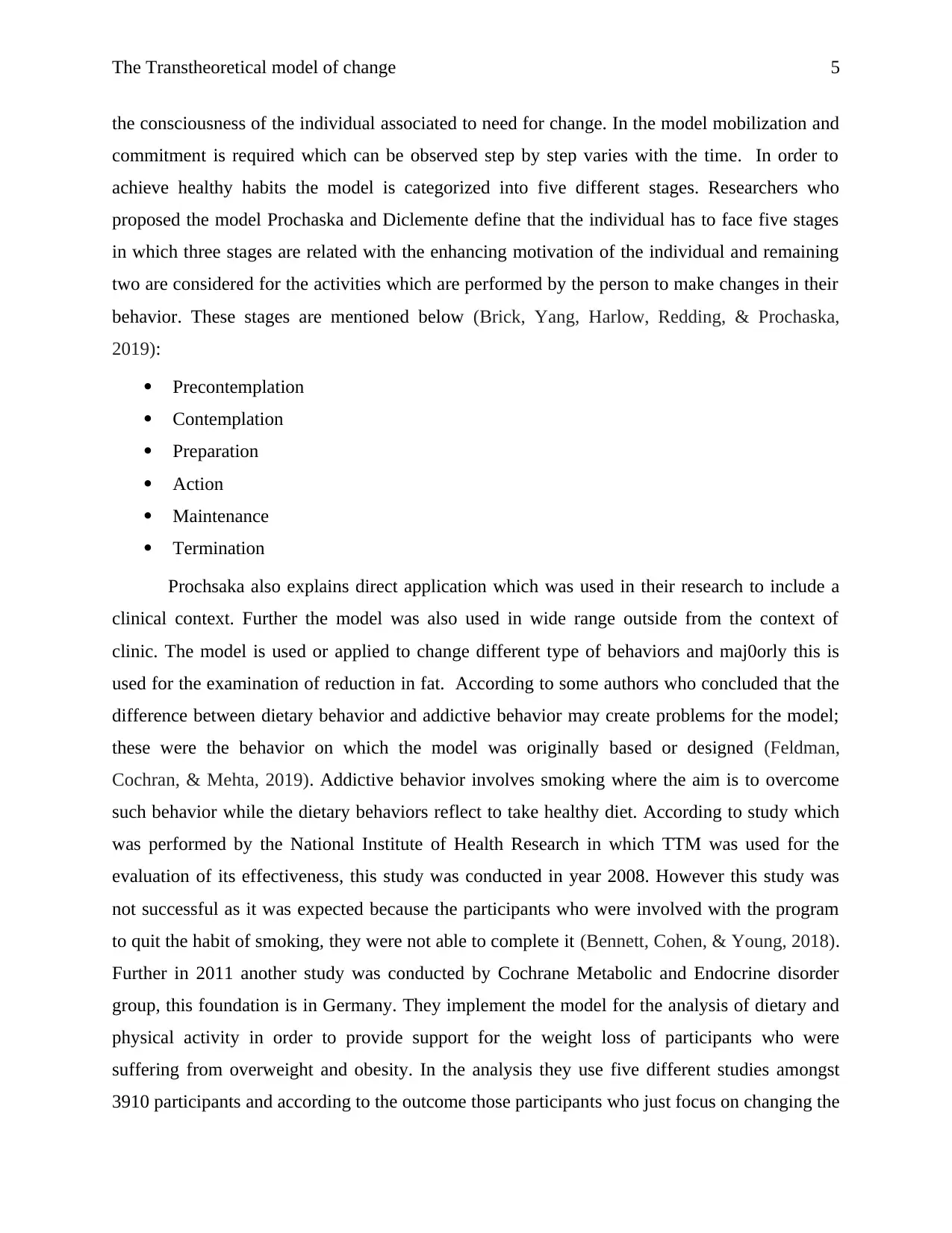
The Transtheoretical model of change 5
the consciousness of the individual associated to need for change. In the model mobilization and
commitment is required which can be observed step by step varies with the time. In order to
achieve healthy habits the model is categorized into five different stages. Researchers who
proposed the model Prochaska and Diclemente define that the individual has to face five stages
in which three stages are related with the enhancing motivation of the individual and remaining
two are considered for the activities which are performed by the person to make changes in their
behavior. These stages are mentioned below (Brick, Yang, Harlow, Redding, & Prochaska,
2019):
Precontemplation
Contemplation
Preparation
Action
Maintenance
Termination
Prochsaka also explains direct application which was used in their research to include a
clinical context. Further the model was also used in wide range outside from the context of
clinic. The model is used or applied to change different type of behaviors and maj0orly this is
used for the examination of reduction in fat. According to some authors who concluded that the
difference between dietary behavior and addictive behavior may create problems for the model;
these were the behavior on which the model was originally based or designed (Feldman,
Cochran, & Mehta, 2019). Addictive behavior involves smoking where the aim is to overcome
such behavior while the dietary behaviors reflect to take healthy diet. According to study which
was performed by the National Institute of Health Research in which TTM was used for the
evaluation of its effectiveness, this study was conducted in year 2008. However this study was
not successful as it was expected because the participants who were involved with the program
to quit the habit of smoking, they were not able to complete it (Bennett, Cohen, & Young, 2018).
Further in 2011 another study was conducted by Cochrane Metabolic and Endocrine disorder
group, this foundation is in Germany. They implement the model for the analysis of dietary and
physical activity in order to provide support for the weight loss of participants who were
suffering from overweight and obesity. In the analysis they use five different studies amongst
3910 participants and according to the outcome those participants who just focus on changing the
the consciousness of the individual associated to need for change. In the model mobilization and
commitment is required which can be observed step by step varies with the time. In order to
achieve healthy habits the model is categorized into five different stages. Researchers who
proposed the model Prochaska and Diclemente define that the individual has to face five stages
in which three stages are related with the enhancing motivation of the individual and remaining
two are considered for the activities which are performed by the person to make changes in their
behavior. These stages are mentioned below (Brick, Yang, Harlow, Redding, & Prochaska,
2019):
Precontemplation
Contemplation
Preparation
Action
Maintenance
Termination
Prochsaka also explains direct application which was used in their research to include a
clinical context. Further the model was also used in wide range outside from the context of
clinic. The model is used or applied to change different type of behaviors and maj0orly this is
used for the examination of reduction in fat. According to some authors who concluded that the
difference between dietary behavior and addictive behavior may create problems for the model;
these were the behavior on which the model was originally based or designed (Feldman,
Cochran, & Mehta, 2019). Addictive behavior involves smoking where the aim is to overcome
such behavior while the dietary behaviors reflect to take healthy diet. According to study which
was performed by the National Institute of Health Research in which TTM was used for the
evaluation of its effectiveness, this study was conducted in year 2008. However this study was
not successful as it was expected because the participants who were involved with the program
to quit the habit of smoking, they were not able to complete it (Bennett, Cohen, & Young, 2018).
Further in 2011 another study was conducted by Cochrane Metabolic and Endocrine disorder
group, this foundation is in Germany. They implement the model for the analysis of dietary and
physical activity in order to provide support for the weight loss of participants who were
suffering from overweight and obesity. In the analysis they use five different studies amongst
3910 participants and according to the outcome those participants who just focus on changing the
You're viewing a preview
Unlock full access by subscribing today!
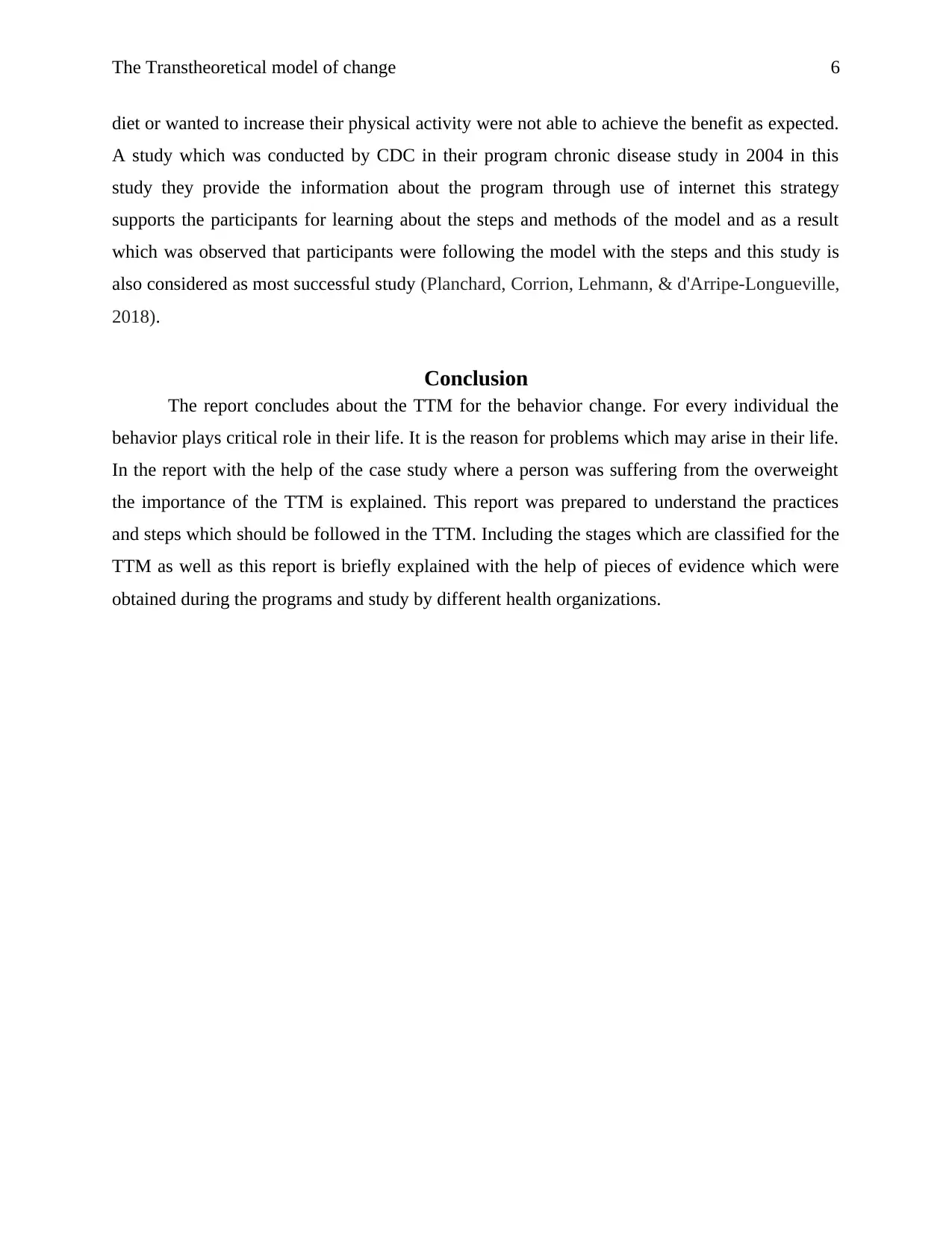
The Transtheoretical model of change 6
diet or wanted to increase their physical activity were not able to achieve the benefit as expected.
A study which was conducted by CDC in their program chronic disease study in 2004 in this
study they provide the information about the program through use of internet this strategy
supports the participants for learning about the steps and methods of the model and as a result
which was observed that participants were following the model with the steps and this study is
also considered as most successful study (Planchard, Corrion, Lehmann, & d'Arripe-Longueville,
2018).
Conclusion
The report concludes about the TTM for the behavior change. For every individual the
behavior plays critical role in their life. It is the reason for problems which may arise in their life.
In the report with the help of the case study where a person was suffering from the overweight
the importance of the TTM is explained. This report was prepared to understand the practices
and steps which should be followed in the TTM. Including the stages which are classified for the
TTM as well as this report is briefly explained with the help of pieces of evidence which were
obtained during the programs and study by different health organizations.
diet or wanted to increase their physical activity were not able to achieve the benefit as expected.
A study which was conducted by CDC in their program chronic disease study in 2004 in this
study they provide the information about the program through use of internet this strategy
supports the participants for learning about the steps and methods of the model and as a result
which was observed that participants were following the model with the steps and this study is
also considered as most successful study (Planchard, Corrion, Lehmann, & d'Arripe-Longueville,
2018).
Conclusion
The report concludes about the TTM for the behavior change. For every individual the
behavior plays critical role in their life. It is the reason for problems which may arise in their life.
In the report with the help of the case study where a person was suffering from the overweight
the importance of the TTM is explained. This report was prepared to understand the practices
and steps which should be followed in the TTM. Including the stages which are classified for the
TTM as well as this report is briefly explained with the help of pieces of evidence which were
obtained during the programs and study by different health organizations.
Paraphrase This Document
Need a fresh take? Get an instant paraphrase of this document with our AI Paraphraser
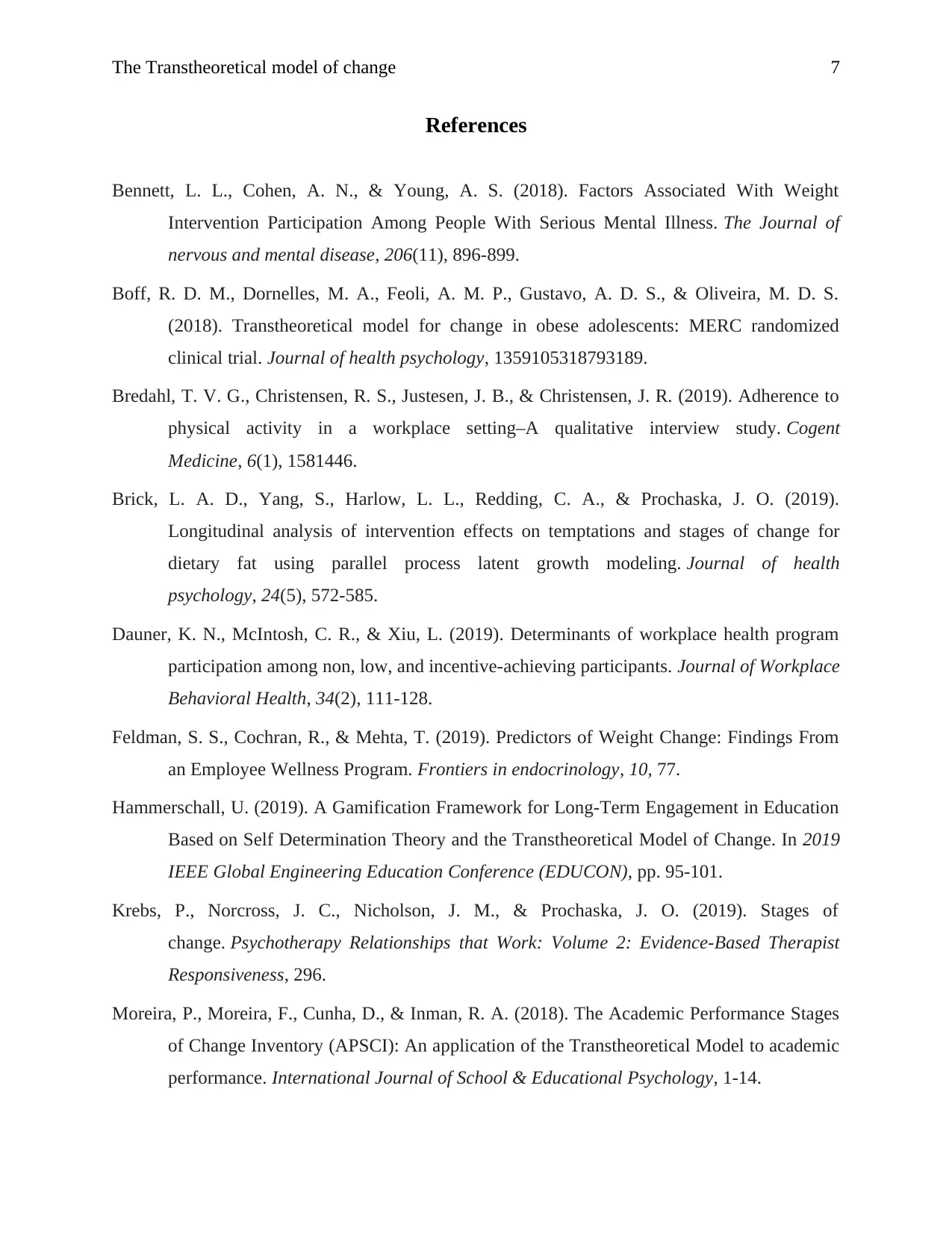
The Transtheoretical model of change 7
References
Bennett, L. L., Cohen, A. N., & Young, A. S. (2018). Factors Associated With Weight
Intervention Participation Among People With Serious Mental Illness. The Journal of
nervous and mental disease, 206(11), 896-899.
Boff, R. D. M., Dornelles, M. A., Feoli, A. M. P., Gustavo, A. D. S., & Oliveira, M. D. S.
(2018). Transtheoretical model for change in obese adolescents: MERC randomized
clinical trial. Journal of health psychology, 1359105318793189.
Bredahl, T. V. G., Christensen, R. S., Justesen, J. B., & Christensen, J. R. (2019). Adherence to
physical activity in a workplace setting–A qualitative interview study. Cogent
Medicine, 6(1), 1581446.
Brick, L. A. D., Yang, S., Harlow, L. L., Redding, C. A., & Prochaska, J. O. (2019).
Longitudinal analysis of intervention effects on temptations and stages of change for
dietary fat using parallel process latent growth modeling. Journal of health
psychology, 24(5), 572-585.
Dauner, K. N., McIntosh, C. R., & Xiu, L. (2019). Determinants of workplace health program
participation among non, low, and incentive-achieving participants. Journal of Workplace
Behavioral Health, 34(2), 111-128.
Feldman, S. S., Cochran, R., & Mehta, T. (2019). Predictors of Weight Change: Findings From
an Employee Wellness Program. Frontiers in endocrinology, 10, 77.
Hammerschall, U. (2019). A Gamification Framework for Long-Term Engagement in Education
Based on Self Determination Theory and the Transtheoretical Model of Change. In 2019
IEEE Global Engineering Education Conference (EDUCON), pp. 95-101.
Krebs, P., Norcross, J. C., Nicholson, J. M., & Prochaska, J. O. (2019). Stages of
change. Psychotherapy Relationships that Work: Volume 2: Evidence-Based Therapist
Responsiveness, 296.
Moreira, P., Moreira, F., Cunha, D., & Inman, R. A. (2018). The Academic Performance Stages
of Change Inventory (APSCI): An application of the Transtheoretical Model to academic
performance. International Journal of School & Educational Psychology, 1-14.
References
Bennett, L. L., Cohen, A. N., & Young, A. S. (2018). Factors Associated With Weight
Intervention Participation Among People With Serious Mental Illness. The Journal of
nervous and mental disease, 206(11), 896-899.
Boff, R. D. M., Dornelles, M. A., Feoli, A. M. P., Gustavo, A. D. S., & Oliveira, M. D. S.
(2018). Transtheoretical model for change in obese adolescents: MERC randomized
clinical trial. Journal of health psychology, 1359105318793189.
Bredahl, T. V. G., Christensen, R. S., Justesen, J. B., & Christensen, J. R. (2019). Adherence to
physical activity in a workplace setting–A qualitative interview study. Cogent
Medicine, 6(1), 1581446.
Brick, L. A. D., Yang, S., Harlow, L. L., Redding, C. A., & Prochaska, J. O. (2019).
Longitudinal analysis of intervention effects on temptations and stages of change for
dietary fat using parallel process latent growth modeling. Journal of health
psychology, 24(5), 572-585.
Dauner, K. N., McIntosh, C. R., & Xiu, L. (2019). Determinants of workplace health program
participation among non, low, and incentive-achieving participants. Journal of Workplace
Behavioral Health, 34(2), 111-128.
Feldman, S. S., Cochran, R., & Mehta, T. (2019). Predictors of Weight Change: Findings From
an Employee Wellness Program. Frontiers in endocrinology, 10, 77.
Hammerschall, U. (2019). A Gamification Framework for Long-Term Engagement in Education
Based on Self Determination Theory and the Transtheoretical Model of Change. In 2019
IEEE Global Engineering Education Conference (EDUCON), pp. 95-101.
Krebs, P., Norcross, J. C., Nicholson, J. M., & Prochaska, J. O. (2019). Stages of
change. Psychotherapy Relationships that Work: Volume 2: Evidence-Based Therapist
Responsiveness, 296.
Moreira, P., Moreira, F., Cunha, D., & Inman, R. A. (2018). The Academic Performance Stages
of Change Inventory (APSCI): An application of the Transtheoretical Model to academic
performance. International Journal of School & Educational Psychology, 1-14.
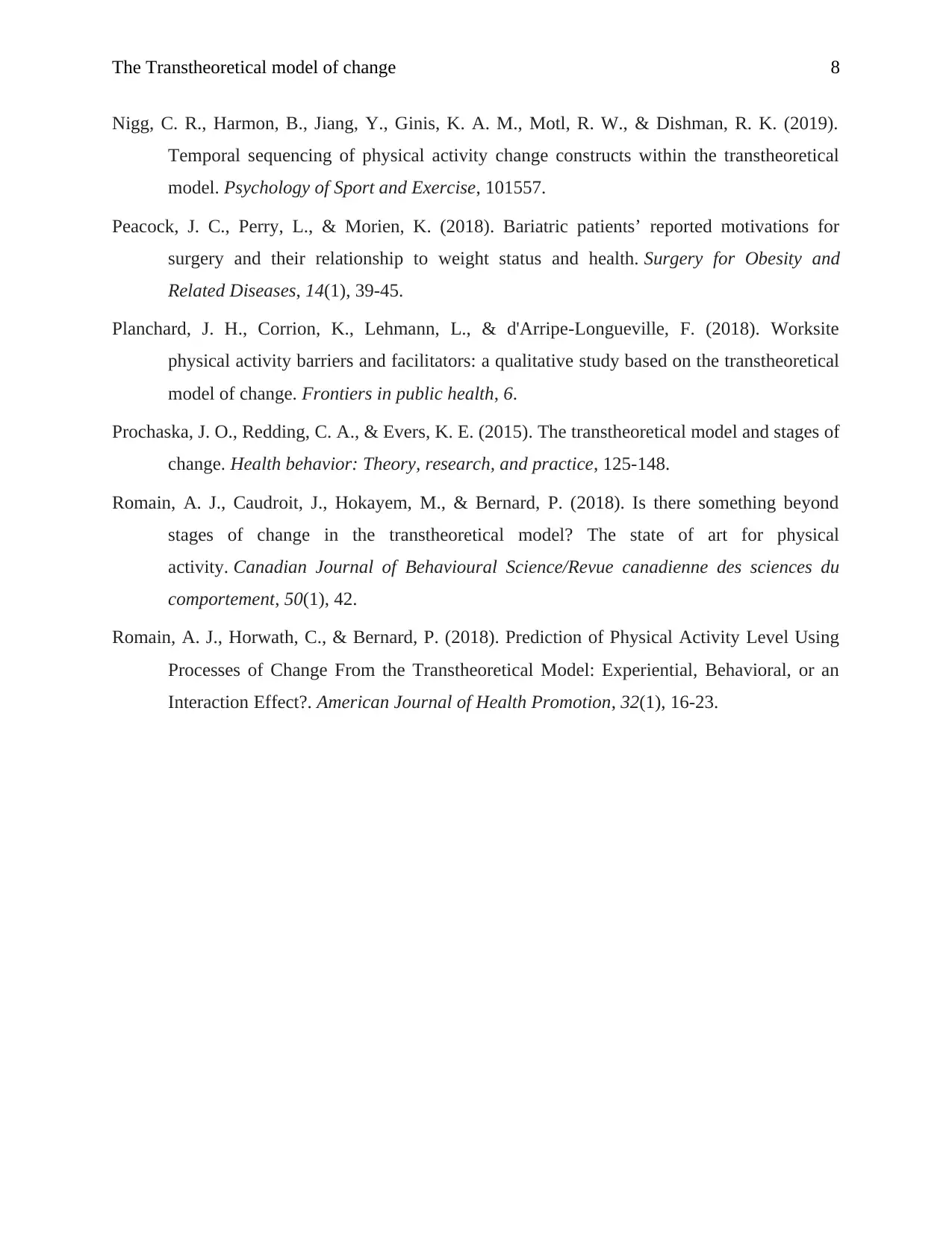
The Transtheoretical model of change 8
Nigg, C. R., Harmon, B., Jiang, Y., Ginis, K. A. M., Motl, R. W., & Dishman, R. K. (2019).
Temporal sequencing of physical activity change constructs within the transtheoretical
model. Psychology of Sport and Exercise, 101557.
Peacock, J. C., Perry, L., & Morien, K. (2018). Bariatric patients’ reported motivations for
surgery and their relationship to weight status and health. Surgery for Obesity and
Related Diseases, 14(1), 39-45.
Planchard, J. H., Corrion, K., Lehmann, L., & d'Arripe-Longueville, F. (2018). Worksite
physical activity barriers and facilitators: a qualitative study based on the transtheoretical
model of change. Frontiers in public health, 6.
Prochaska, J. O., Redding, C. A., & Evers, K. E. (2015). The transtheoretical model and stages of
change. Health behavior: Theory, research, and practice, 125-148.
Romain, A. J., Caudroit, J., Hokayem, M., & Bernard, P. (2018). Is there something beyond
stages of change in the transtheoretical model? The state of art for physical
activity. Canadian Journal of Behavioural Science/Revue canadienne des sciences du
comportement, 50(1), 42.
Romain, A. J., Horwath, C., & Bernard, P. (2018). Prediction of Physical Activity Level Using
Processes of Change From the Transtheoretical Model: Experiential, Behavioral, or an
Interaction Effect?. American Journal of Health Promotion, 32(1), 16-23.
Nigg, C. R., Harmon, B., Jiang, Y., Ginis, K. A. M., Motl, R. W., & Dishman, R. K. (2019).
Temporal sequencing of physical activity change constructs within the transtheoretical
model. Psychology of Sport and Exercise, 101557.
Peacock, J. C., Perry, L., & Morien, K. (2018). Bariatric patients’ reported motivations for
surgery and their relationship to weight status and health. Surgery for Obesity and
Related Diseases, 14(1), 39-45.
Planchard, J. H., Corrion, K., Lehmann, L., & d'Arripe-Longueville, F. (2018). Worksite
physical activity barriers and facilitators: a qualitative study based on the transtheoretical
model of change. Frontiers in public health, 6.
Prochaska, J. O., Redding, C. A., & Evers, K. E. (2015). The transtheoretical model and stages of
change. Health behavior: Theory, research, and practice, 125-148.
Romain, A. J., Caudroit, J., Hokayem, M., & Bernard, P. (2018). Is there something beyond
stages of change in the transtheoretical model? The state of art for physical
activity. Canadian Journal of Behavioural Science/Revue canadienne des sciences du
comportement, 50(1), 42.
Romain, A. J., Horwath, C., & Bernard, P. (2018). Prediction of Physical Activity Level Using
Processes of Change From the Transtheoretical Model: Experiential, Behavioral, or an
Interaction Effect?. American Journal of Health Promotion, 32(1), 16-23.
You're viewing a preview
Unlock full access by subscribing today!
1 out of 9
Related Documents
Your All-in-One AI-Powered Toolkit for Academic Success.
+13062052269
info@desklib.com
Available 24*7 on WhatsApp / Email
![[object Object]](/_next/static/media/star-bottom.7253800d.svg)
Unlock your academic potential
© 2024 | Zucol Services PVT LTD | All rights reserved.





